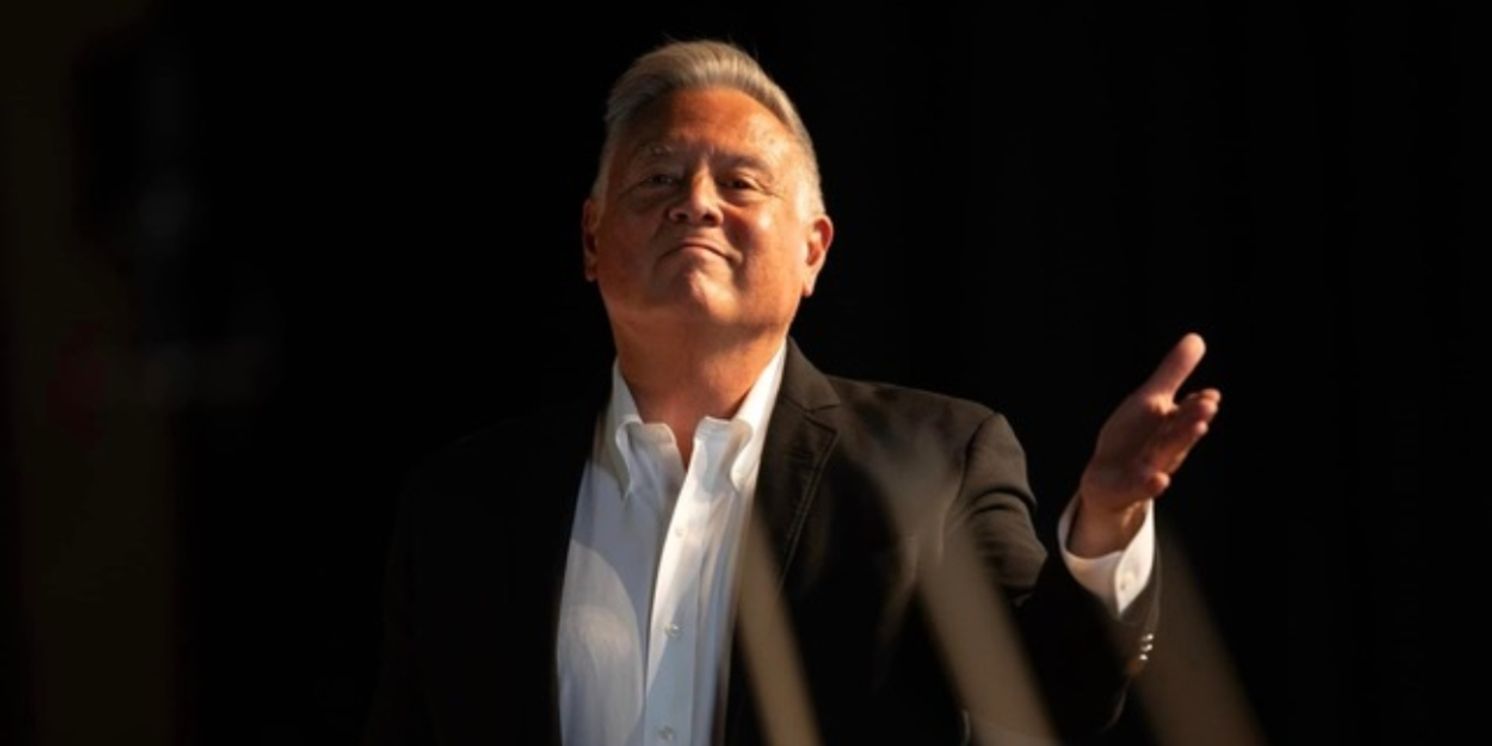A FORTY SECOND STREET STORY: The Extraordinary Career of Kevin Stites
Celebrated Music Director Conductor, Pianist, Arranger Makes MSMT Debut

As soon as the orchestra launches into the opening bars of Maine State Music Theatre’s current production of Anastasia, there is a frisson of electricity that runs through the house. On the podium and at the keyboards, making his MSMT debut, is Kevin Stites, the nationally celebrated conductor, pianist, music director, and arranger – an artist with a storied career that includes thirteen Broadway shows, seven National Broadway Tours, six seasons conducting the Radio City Christmas Spectacular, countless pops concerts at venues like the Hollywood Bowl, Ravinia, Carnegie Hall, and David Geffen Hall, as well as recitals, film, and television.
In a career that has taken Maestro Stites from Pecatonica, a small Illinois town west of Chicago, to national recognition, this moment in another small town in Maine may feel like a kind of homecoming, a reunion with old friends and colleagues and an opportunity to explore Anastasia, a score he calls “surprisingly beautiful and often overlooked.”
Stites recalls being introduced to music and the piano at an early age by his grandmother, who recognized his musical ability. “At the age of three, I could play basic chords, and play songs along, with her She taught him to read music and learn harmony. When Stites was in seventh grade, he began taking organ lessons with a teacher in neighboring Rockford, and he continued his musical education “with the excellent band and choral teachers” he had at Pecatonica High School. “I accompanied the choir, and the choir director got me to my first piano teacher at the local community college when I was a high school sophomore. And when it came time to go to college, I was inspired by my choral and band directors to pursue music education. I wanted to be the next great Mr. Holland.”
Stites enrolled in the University of Illinois Urbana-Champaign where he soon changed his major to applied piano. “I studied piano with Kenneth Drake, “who owned a number of world renowned Broadway pianos and was a pure inspiration to me. He arranged to have me play for John Wustman, [the famous recital pianist who taught in the graduate school], and he [Wustman] took me on as an accompanist student while I was an undergraduate junior.” After taking his Bachelor’s degree, Stites officially entered Wustman’s graduate program and was working toward his Master of Music when another fortuitous opportunity presented itself.
“It was like a Forty-second Street story,” he says, recalling the series of events that brought him to Chicago and then New York. “I went to see a friend who was in a production at the Marriott Lincolnshire, and there was to be a cabaret in the bar of the resort after the show, but the pianist had gotten sick at the last minute. My friend suggested me. The Marriott producer and artistic director were at the cabaret, and I sight read the music and played the performance. They ended up offering me a two-year contract, but that would have meant I had to leave school with one semester yet to finish for my degree. I went to John Wustman for advice. He told me, ‘It’s simple: resign your fellowship, finish your Italian course by correspondence, and take the job.’ And that is how I came to work in musical theatre.”
“I had always been in love with musical theatre,” Stites continues. “In high school I would listen to cast albums, and I performed – badly, I might add – in the school musical, but I never thought I could make a career doing musical theatre. Then, here I was, having fallen into a job, and I went on to do over seventy shows at the Marriott.”
From that point, Stites began to expand his musical theatre resumé. He worked with Cameron MacIntosh’s organization on the National Tours of Phantom, Led Miserables, Miss Saigon, and others. “I spent years on the road, and then in 1995 when Betty Buckley went into Sunset Boulevard on Broadway, I went to New York. My Broadway debut as Music Director/Conductor was in Titanic; that show was hugely influential in my career. I loved the process of originating a new musical like Titanic; it had a great deal of trouble in previews and was rewritten before it opened, but New York loved it. It won five Tonys and ran for two years.”
Stites cites other Broadway shows that have been highlights for hIm. “I loved conducting the revivals of Nine with Antonio Banderas and On The Twentieth Century with Kristin Chenowith, as well as Fiddler On The Roof with Alfred Molina; having writers Bock and Harnick with us through rehearsals was very special.” After the Chenoweth show, Stites took up his baton at Radio City Music Hall, conducting six seasons of the Christmas Spectacular.
“When Covid hit, I thought I would never work again. I moved back to Pecatonica and lived in my renovated family home. And then [as the world emerged from the pandemic], a new career conducting pops concerts cropped up. I worked at the Hollywood Bowl, Ravinia, Carnegie Hall and Davud Geffen Hall conducting composers like Henry Mancini and Stephen Sondheim. I love doing pop concerts. The work is incredibly hard and then you move on.” Stites also continues to maintain close ties with the Rockford Symphony –“my home orchestra” – where he is Principal Pops Conductor and programs four annual concerts. “I am now preparing for a July spectacular concert there,” as well as embarking on a position at the Savannah College of Arts and Design working for thirty weeks as Music Director for the Acting Department. “It’s a beautiful, charming city – one where you expect to see Rhett Butler on every corner – and when I mentored there last year, I discovered how wonderful and eager to learn the students are.”
But for the moment Stites finds himself in Brunswick, Maine, as Music Director of Anastasia, having just finished a run of the production at the Fulton Theatre. He recounts how the invitation came about: “I have known Marc [Robin, Executive Artistic Producer of the Fulton] from Rockford and Curt [Dale Clark, Artistic Director of MSMT] for decades. Actually, I have known Curt since he was four years old in Pecatonica; our families were neighbors and friends, and I even taught him briefly as a music substitute when he was a sophomore in high school. I used to tease them, asking when they were going to hire me. Then last year I got a call from both of them inviting me to do Anastasia, and here I am!”
Stites loves Stephen Flaherty’s score. “He really embraces a Romantic vision – sort of Rachmaninoff meets Mussorgsky with a little bit of Brahms melded with contemporary Broadway [sound]. He successfully captures the modality of Russian folk music and classical music, as well as writing some first rate power ballads and show music.”
Asked how Stites manages to elicit such a grand, lush sound from the nine-person MSMT orchestra, he replies: “A lot of it is created by very sophisticated keyboards programming. My book [on first keyboards] uses lots of piano, harp and keyboard sounds, but the second keyboards uses every other instrument in the orchestra – lots of strings, percussion, bassoon. It’s very difficult to play; you have to change patches almost every measure, and sometimes one hand is playing something entirely different from the other.”
Stites observes that the vocal writing is equally complex. “Dimitry has a high, high tessitura; Gleb is a heroic baritenor; Vlad is a character man, and Anya’s music has a contemporary Broadway feel with some big notes. And she is always talking or singing, so the role is very demanding.” Then there is the choral music – a specialty for which the maestro is famous. “I like to consider myself a choral person. In Act One I’ve instructed the ensemble to sing as if they are in BORIS GUDONOV at the Met in a very legitimate manner, and then when they move to Paris in Act Two to make the sound more bright and light in a musical theatre mode.”
“Flaherty did his own choral arranging – something Broadway composers don’t often do – and he knows what he is doing! The first fifteen minutes of the show are entirely musicalized from the cinematic underscoring, the music box song, the grand waltz and culminating in the big ensemble number, ‘A Rumor in St. Petersburg.’ [Sequencing] so many different styles all in a row is very hard. There are also some quieter, sweet, simple moments that are refreshing, and it’s fun to play the cinematic underscoring and sync it with what is happening on stage- which is always a challenge because it is never the same.”
Not only is Stites reveling in the beauties of the music he gets to play and conduct each evening, but he confides that he is finding the entire MSMT experience very special. Much of that has to do with the old friends and colleagues with whom he has been working. “The world of theatre is smaller than people might think. And when one has true friendship that goes back decades, as I do with Marc and Curt, that is something to cherish. The same is true for his connection to Mary Ernster, who plays the Dowager Empress, whom he has also known from his Chicago days. “I played for her graduate recital at Northwestern, and we became so close that she became godmother to my daughter, and when Mary was on Broadway in WAR PAINT, she lived with me in New York for a year. So this is a real treat for me.”
Kevin Stites pauses for a minute, then adds: “Curt and his entire staff have been wonderful hosts. They made us all feel very welcome, very appreciated, very special. Of the regional theatres at which I’ve worked, this [MSMT] is the place I love the most.”
Photo courtesy of MSMT

Videos

